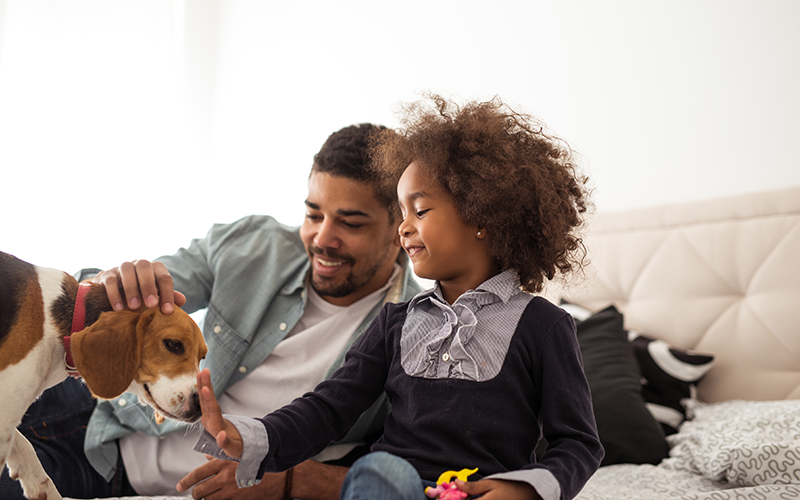It’s National Animal Safety and Protection Month—a time dedicated to helping promote information to pet owners to help them protect their pets. In support of this, here are five simple tips that you can share with your clients to better ensure the health and safety of their pets, this month and all year long:
1. Keep Halloween Treats Away From Your Pet
With boxes and bags of Halloween treats sliding onto grocery store shelves earlier and earlier every year, there is the temptation to bring them home earlier. Whether you have some already or will be bringing them home soon (along with an adorable Halloween costume for your pet, of course!), resist the temptation to share them with your pets. Chocolate and candy (or gum) artificially sweetened with xylitol can be extremely dangerous for dogs.
In large amounts, chocolate can be fatal to dogs from a compound called theobromine. Similar to caffeine, and found in all forms of chocolate (dry cocoa powder, baking chocolate, cacao, and candy bars as well as tea, cola beverages and açaí berries), theobromine is considered toxic—and tempting, especially when left sitting around unguarded. The darker the chocolate, the more toxic it is.
Food sweetened with xylitol can be lethal for dogs. As a sugar substitute found in candies and gum (as well as diet baked goods and other foods), xylitol is rapidly absorbed into a pet’s bloodstream and can cause hypoglycemia (low blood sugar), liver failure, seizures, and even death in dogs.
2. Make Your Car Pet-Safe for Travel
Each October and November means Thanksgiving travel plans for millions of people across North America. If you’re traveling by car and bringing your dog, consider a dog crate set up and secured on the back seat or in the rear compartment of a van or SUV. There are also several well-designed safety harnesses (or, “doggy seatbelts”) for restraint in the back seat.
If you travel with open windows, make sure the opening is too small for your dog’s head to fit through. Yes, dogs generally love to stick their heads out the window to experience the rush of the wind, a million scents (and stories!) all at once, but a flying piece of gravel or insect could easily cause injury. Also, be sure to set the child lock on power windows so your dog can’t accidentally open or close a window on his own by stepping on the button. If he was to stick his head out an open window and then accidentally close the window on himself, he could suffer a serious neck injury or even suffocate.
Above all, make sure your dog wears a collar with ID tags at all times or has been microchipped. Things happen on road trips: stopping for coffee, grabbing snacks, etc. Doors get opened, and if you dog should get loose and run away, you want to be sure your dog has proper ID to be safely returned home.
3. Pet-Proof Your Home
Most pet owners do not think about pet-proofing their homes as they would baby-proofing a home. However, there are many toxic and dangerous things that pets can get into, chew on, or swallow (especially if they’re extra-curious or bored):
- Household medications such as blood-pressure pills and antidepressants
- Unbaked bread dough
- Seemingly innocent but pet-dangerous plants like lilies, aloe vera, and elephant ear
- Common pain relivers like Advil (ibuprofen) and Tylenol (acetaminophen)
- Low-hanging electrical cords
- Cleaning fluids and chemicals
- Tobacco and other nicotine products like patches, gum, and vaping cartridges
Carefully walk through your home to make sure all pet-dangerous products are safely put away. Make sure all low-hanging electrical cords and dangerous plants are out of reach. If you see your pet eating anything toxic or exhibiting any unusual signs, immediately call your veterinarian or the Pet Poison Helpline, available in North America by calling 800-213-6680.
4. Bag Up the Rubber Bands and String
Cats are naturally curious and love to play with (and ingest!) bits of string or rubber bands that they discover lying around. Many of these foreign objects pass through the digestive tract without issue. It’s common for owners to find all sorts of objects in their cat’s vomit or stool. Yet not all objects will pass through without complications. One of the more common and potentially life-threatening conditions seen in veterinary practices is foreign body obstruction, which commonly requires surgical removal. To avoid this, bag up bits of string and rubber bands and stow them safely away in a drawer.
5. Purchase Pet Insurance
We all hope our pets will live long and healthy lives. Yet unexpected things happen, and pets can get sick or injured. When pet owners don’t have the money to pay for veterinary care, they must resort to savings, credit cards, or loans to cover the costs, or worse. In some cases, owners face the agonizing decision to put a pet down because they cannot afford treatment. Pet insurance empowers pet owners to make health care decisions based on what’s best for their pets versus being constrained by finances.
Trying to navigate through the various insurance plans offered by different pet insurance companies can be intimidating and confusing for many pet owners. To help with that, the LifeLearn PetInsuranceInfo.com website is a free service that helps pet owners learn what pet insurance is, what it isn’t, and the questions they need to ask prior to purchasing a policy. PetInsuranceInfo.com even provides a simple tool for pet owners to compare different insurance coverage and quotes from most pet insurance providers in North America.
Visit petinsuranceinfo.com for more.






